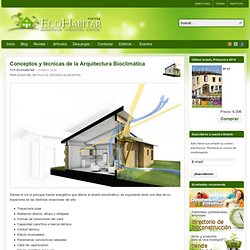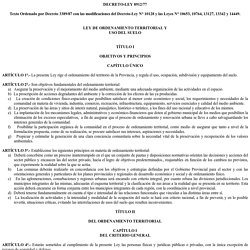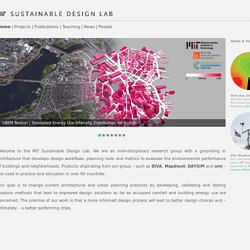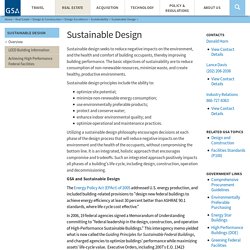

Zaha Hadid Architects + Dr. Brian Sinclair: Culturally Sustainable Design Talk. No confundas SOSTENIBILIDAD, BIOCLIMÁTICA, VERNÁCULA y más. Centro de Recursos de Certificación - DNV GL. Desarrollo sustentable. Concepto y 22 Ejemplos de proyectos. GreenSpec - Green Building Design, Products and Materials in the UK. Arquitectura Verde y Sistemas de Certificación aplicado a edificaciones sostenibles by LuisFer Castillo. Conceptos y técnicas de la Arquitectura Bioclimática. Siendo el sol la principal fuente energética que afecta al diseño bioclimático, es importante tener una idea de su trayectoria en las distintas estaciones del año.

Trayectoria solar Radiación directa, difusa y reflejada Formas de transmisión del calor Capacidad calorífica e inercia térmica Confort térmico Efecto invernadero Fenómenos convectivos naturales Calor de vaporización Efecto climático del suelo Pérdida de calor en viviendas (invierno) Microclima y ubicación Ubicación Forma y orientación Captación solar pasiva Aislamiento y masa térmica Ventilación Aprovechamiento climático del suelo Espacios tapón Protección contra la radiación de verano Sistemas evaporativos de refrigeración Trayectoria solar Sin entrar en detalles técnicos, y particularizando para el hemisferio norte, por encima del trópico de Cáncer (es decir, una situación geográfica en la que está España): También hay que tener en cuenta que el horario solar no es el horario oficial.
Conducción. Renewable energies #9 - Daylight & Architecture Magazine by VELUX Group. The Social Dimensions of Climate Change by World Bank Publications. Ppt arquitectura sostenible by Luisa Pineda. Arquitectura sustentable by Caro Panchi. Construcción Sostenible ed 7 by LEGIS SA. Padilla, s (2012) hábitat sustentable by antonio. Buildgreen Magazine - Edicion #2 by Argentina Green Building Council. BVSDE Desarrollo Sostenible. Materiales gbce – Plataforma materiales online de gbce. Eco-habitat par la Recherche et l’Architecture. DECRETO-LEY 8912/77.
Texto Ordenado por Decreto 3389/87 con las modificaciones del Decreto-Ley N° 10128 y las Leyes N° 10653, 10764, 13127, 13342 y 14449.

ARTÍCULO 1°.- La presente Ley rige el ordenamiento del territorio de , y regula el uso, ocupación, subdivisión y equipamiento del suelo. ARTÍCULO 2°.- Son objetivos fundamentales del ordenamiento territorial: a) Asegurar la preservación y el mejoramiento del medio ambiente, mediante una adecuada organización de las actividades en el espacio. b) La proscripción de acciones degradantes del ambiente y la corrección de los efectos de las ya producidas. c) La creación de condiciones físico-espaciales que posibiliten satisfacer al menor costo económico y social, los requerimientos y necesidades de la comunidad en materia de vivienda, industria, comercio, recreación, infraestructura, equipamiento, servicios esenciales y calidad del medio ambiente.
ARTÍCULO 3°.- Establécense los siguientes principios en materia de ordenamiento territorial: a) Áreas rurales. 1. A) Area : MIT Sustainable Design Lab. Welcome to the MIT Sustainable Design Lab.

We are an inter-disciplinary research group with a grounding in architecture that develops design workflows, planning tools and metrics to evaluate the environmental performance of buildings and neighborhoods. Products originating from our group – such as DIVA, Mapdwell, DAYSIM and umi – are used in practice and education in over 90 countries. Our goal is to change current architectural and urban planning practices by developing, validating and testing analysis methods that lead to improved design solutions as far as occupant comfort and building energy use are concerned.
The premise of our work is that a more informed design process will lead to better design choices and – ultimately – a better performing cities. News & Features DIVA Day 2017will take place on Oct 27 at the University of California Berkeley more>> SDL Weather stationOur new weather station on top of MIT Building 1 was launched in March more>>Previous News. Sustainable Design.
Sustainable design seeks to reduce negative impacts on the environment, and the health and comfort of building occupants, thereby improving building performance.

The basic objectives of sustainability are to reduce consumption of non-renewable resources, minimize waste, and create healthy, productive environments. Sustainable design principles include the ability to: optimize site potential; minimize non-renewable energy consumption; use environmentally preferable products; protect and conserve water; enhance indoor environmental quality; and optimize operational and maintenance practices. Utilizing a sustainable design philosophy encourages decisions at each phase of the design process that will reduce negative impacts on the environment and the health of the occupants, without compromising the bottom line. It is an integrated, holistic approach that encourages compromise and tradeoffs. ARQUITETURA BIOCLIMÁTICA COMO ALTERNATIVA DE HABITAÇÃO CONTEMPORÂNEA by Luana Coelho.